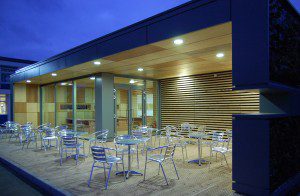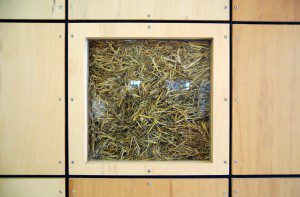 1. Please introduce yourself:
1. Please introduce yourself: I’m Paul Younger, an architect and associate with Hewitt Studios LLP in the UK. Our practice focuses on high-quality, non-traditional sustainable design – just because its green, doesn’t mean it has to be twee or old-fashioned!
Our practice approached by Herefordshire College of Technology to extend and refurbish the refectory facilities on their Holme Lacy agricultural campus to create a 100 seat student cafe. In visiting the site and talking to the users, two things struck us: The first was the abundance of natural resources that the campus possessed (it is effectively a training farm, set in acres of fields and woodland), the second was the enthusiasm of the College staff and students to get involved. It was agreed that, rather than just build an ‘extension’, the new project should be a social ‘hub’ at the heart of the campus. The College would be involved in the design, construction and ongoing maintenance of the building, using as many of their on-site ‘riches’ as possible.

3. What did you think about the process of working with straw bales? What worked well, what was challenging?
We found the process of working with Straw Bales reassuringly ‘low-tech’ and forgiving – we were effectively just stuffing straw in a box! Most of the labour was ‘unskilled’, but we still managed to produce a very credible result under the watchful eye of Modcell. The most challenging part of the process was probably the alignment of the timber frame – this is where the professionals stepped in!
4. Would you work on another straw bale again?
Most certainly, yes! In fact, we are working on four other straw bale buildings as I speak – another for the same client and three more private houses. We have found it to be a very cost-effective and low-impact form of construction, easily within the realms of most contractor’s capabilities.
 5. Do you have a funny/quirky story to share about what someone said in hearing that you were going to be building with straw bales?
5. Do you have a funny/quirky story to share about what someone said in hearing that you were going to be building with straw bales?We had all the usual comments of ‘won’t it burn down?’, ‘what if it gets damp?’, ‘won’t it smell?’ and ‘will mice/rats/birds live in it?’, but probably the funniest reaction was from one of the College students (who had not been involved in the build) after completion. He was absolutely convinced that our straw bale ‘truth window’ was just a sham and that the building was really made by conventional means. ‘I’ve been round the back’ he said, ‘I’ve seen how thin the walls are’. He’d actually seen some of the cladding we’d added to the existing building to make it blend in, but couldn’t be persuaded of this fact!
 6. What has the reception been like to the new building?
6. What has the reception been like to the new building?We do think that this technology represents a viable solution to future building needs and we would love to try it on a larger scale. It is fair to say that there is some reluctance in the British building industry to embrace this method of construction – most contractor’s are quite conservative and see this as a ‘unproven’ or ‘risky’ method of construction. Hopefully, with the example of trail-blazing projects like the Straw Bale Cafe, we can demonstrate that this low-cost, low-carbon technology has the power to make a positive impact on our planet and our lives.



One Response
Hi, I got over to your website via StumbleUpon. Not a thing I typically read, although I really like your opinions nevertheless. Thanks a lot for putting together some thing worthy of reading!